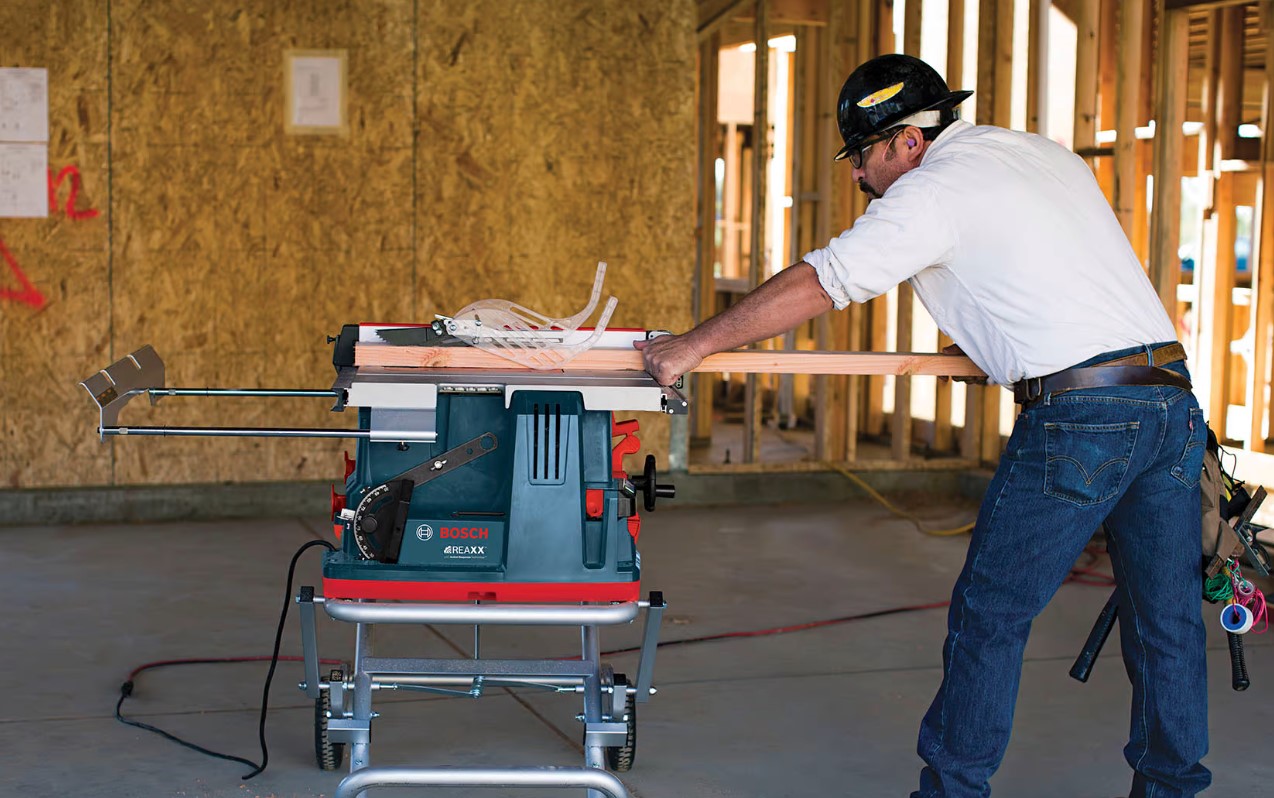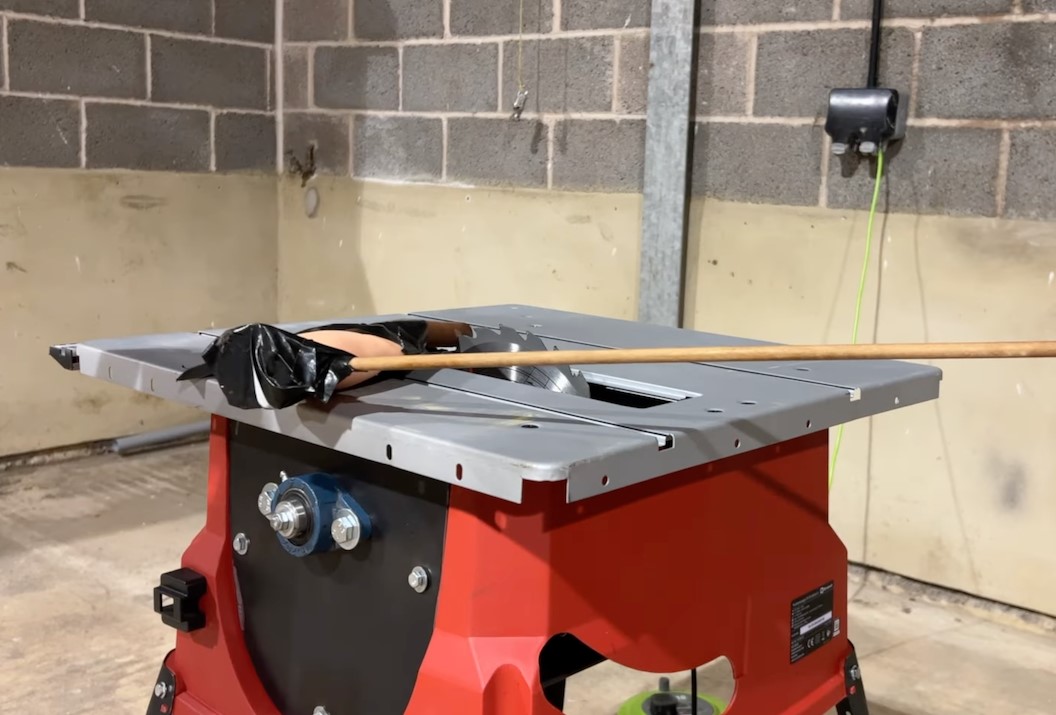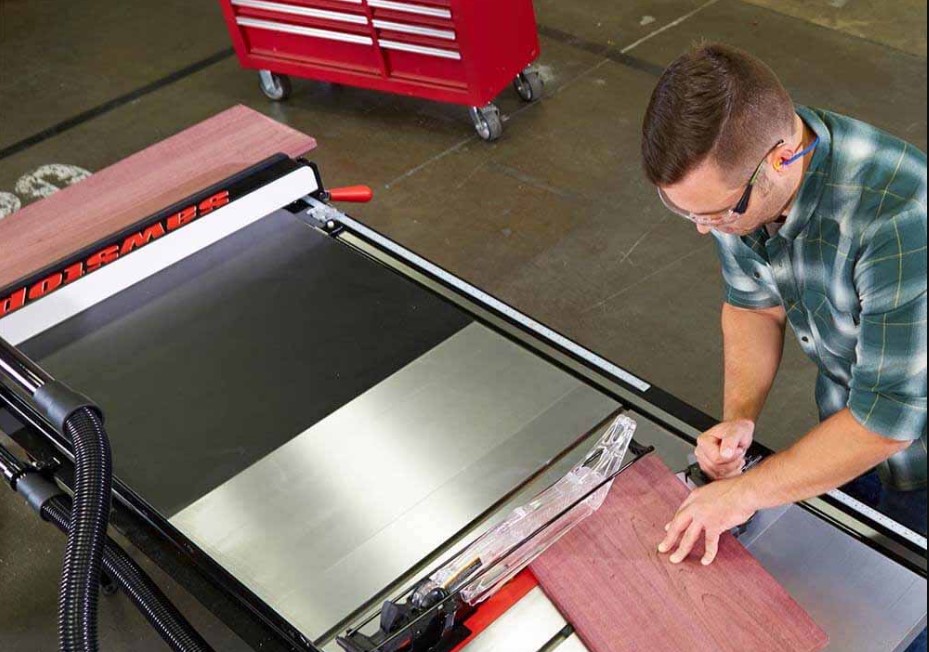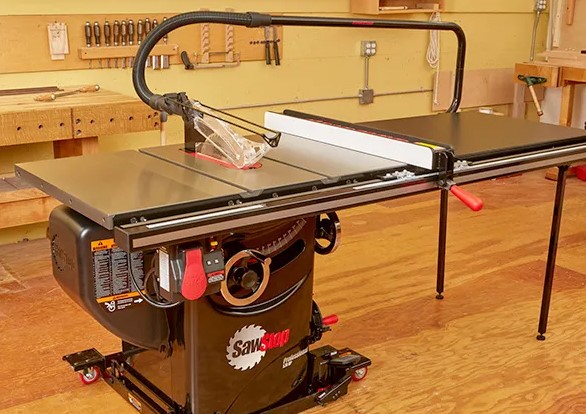Table saws are valuable tools used in woodworking and construction industries, but they also pose significant safety risks, particularly when it comes to finger injuries. This article delves into the crucial topic of table saw safety and explores how these powerful machines detect fingers to prevent accidents. By understanding the mechanisms and technologies involved, individuals can enhance their safety practices and reduce the likelihood of severe injuries.
Table saws have revolutionized the woodworking industry, providing efficiency and precision in cutting various materials. These machines consist of a circular saw blade mounted on an arbor and are commonly used for making straight cuts or intricate designs. While table saws offer numerous benefits, it is essential to prioritize safety to prevent life-altering finger injuries that can occur in a matter of seconds.
The advancements in table saw technology have introduced various safety features designed to mitigate the risk of finger accidents. This article will explore these safety measures in detail, focusing on how table saws can detect fingers and halt the blade’s movement instantaneously. By understanding the underlying mechanisms, users can make informed decisions and develop habits that prioritize safety during woodworking activities.
Understanding the Need for Finger Detection Systems

Finger detection systems in table saws play a vital role in preventing severe finger-related injuries. This section provides an overview of the impact of such injuries and presents statistics that highlight the prevalence of table saw accidents and finger amputations.
Overview of Finger-Related Injuries and Their Impact: Finger injuries caused by table saw accidents can have devastating consequences for individuals. These injuries often involve deep cuts, fractures, and even complete finger amputations. The impact of such injuries extends beyond physical pain, affecting individuals emotionally, psychologically, and financially. Loss of finger function can significantly impair one’s ability to perform daily tasks, engage in work-related activities, and pursue hobbies.
Statistics on Table Saw Accidents and Finger Amputations: Table saw accidents resulting in finger amputations are alarmingly common. According to studies conducted by the U.S. Consumer Product Safety Commission (CPSC), table saw accidents account for a significant number of woodworking-related injuries. The CPSC estimates that approximately 30,000 table saw injuries occur each year, with a substantial portion involving finger-related incidents.
Furthermore, a study published in the Annals of Emergency Medicine reported that finger injuries accounted for around 70% of all table saw-related injuries treated in emergency departments. These statistics highlight the urgent need to implement effective safety measures, such as finger detection systems, to mitigate the risk of finger accidents and their associated consequences.
By understanding the severity of finger injuries and the prevalence of table saw accidents, individuals can recognize the importance of incorporating finger detection systems into table saw technology. The subsequent sections will delve into the various safety mechanisms and technologies that enable table saws to detect fingers and prevent these life-altering accidents from occurring.
The Anatomy of a Table Saw

To understand how table saws detect fingers, it is essential to familiarize ourselves with the key components of these machines and the cutting process they employ. This section provides an explanation of the main elements of a table saw and an overview of the cutting process along with the associated risks.
Explanation of the Key Components of a Table Saw: Table saws consist of several essential components that work together to facilitate cutting operations. These components include:
- Tabletop: The flat surface where the workpiece is placed for cutting.
- Rip Fence: A guide that ensures precise and parallel cuts by keeping the workpiece at a consistent distance from the blade.
- Miter Gauge: A device used to guide the workpiece at various angles for making crosscuts or angled cuts.
- Blade: The circular saw blade, typically made of carbide, that rotates at high speeds to cut through the workpiece.
- Arbor: The shaft on which the blade is mounted and rotates.
- Power Source: Table saws can be powered by electricity or, in some cases, by alternative power sources like batteries.
Overview of the Cutting Process and Associated Risks: The cutting process involves feeding the workpiece through the blade, which results in the desired cut. However, this process poses inherent risks, especially when proper safety precautions are not followed. Some of the risks associated with table saw cutting include:
- Kickback: The sudden and forceful backward movement of the workpiece, which can occur when the blade catches the material, causing it to be propelled towards the operator.
- Contact with the Blade: Accidental contact with the spinning blade can lead to severe cuts and finger injuries.
- Binding: When the workpiece becomes trapped between the blade and other objects, causing the material to bind and potentially kick back.
- Splinters and Flying Debris: The cutting action can generate splinters and debris, posing risks to the operator’s eyes, face, and hands.
Understanding the anatomy of a table saw and the risks associated with the cutting process sets the foundation for comprehending how finger detection systems play a crucial role in mitigating these risks. The following sections will delve into the specific safety measures and technologies employed by table saws to detect fingers and prevent accidents.
Overview of Traditional Safety Measures

Table saws have incorporated traditional safety measures over the years to minimize the risk of accidents and finger injuries. This section provides an overview of three commonly used safety measures: riving knives and splitters, anti-kickback pawls, and blade guards. It also explores their limitations in effectively preventing finger accidents.
Riving Knives and Splitters: Riving knives and splitters are devices installed behind the saw blade, aligned with the cutting path. Their primary function is to prevent kickback and keep the workpiece separated, reducing the likelihood of binding. Riving knives are typically mounted directly onto the arbor assembly, while splitters are removable attachments.
These safety measures work by preventing the workpiece from closing in on the back of the blade, maintaining a consistent distance between the two sections of the cut material. This helps to reduce the risk of kickback and binding, promoting safer cutting operations. However, riving knives and splitters do not provide direct finger detection capabilities and are primarily focused on preventing kickback incidents.
Anti-Kickback Pawls: Anti-kickback pawls are small, toothed devices that attach to the table saw’s rip fence. These pawls are designed to grip the workpiece and prevent it from being propelled backward in the event of a kickback. They are positioned to engage with the workpiece’s surface and resist its movement in the opposite direction to the blade’s rotation.
While anti-kickback pawls offer an additional layer of protection against kickback incidents, they do not directly detect fingers or provide comprehensive finger injury prevention. Their primary purpose is to reduce the likelihood of workpiece movement during kickback situations.
Blade Guards and Their Limitations: Blade guards are transparent or semi-transparent covers that enclose the upper portion of the saw blade. They are intended to protect operators from accidental contact with the spinning blade, as well as to prevent debris and splinters from being ejected towards the operator.
Blade guards offer some level of protection by acting as a physical barrier between the operator’s fingers and the blade. However, they often have limitations in terms of obstructing visibility, impeding the use of certain cutting techniques, and being removed or bypassed by operators due to inconvenience. This can compromise their effectiveness in preventing finger accidents.
While these traditional safety measures provide valuable layers of protection, they have inherent limitations in detecting fingers and providing comprehensive safety against finger injuries. To overcome these limitations, advanced safety technologies, such as finger detection systems, have been developed and integrated into modern table saws. The subsequent sections will explore these technologies in more detail.
How Modern Table Saws Detect Fingers

With the aim of enhancing table saw safety, modern advancements have introduced innovative finger detection technologies. This section provides an introduction to these advanced safety technologies, focusing on the pioneering system called SawStop. Additionally, it explores other finger detection technologies such as flesh-sensing technology and laser-based systems.
Introduction to Advanced Safety Technologies: Modern table saws are equipped with sophisticated safety technologies designed to detect fingers and swiftly stop the blade’s movement to prevent severe injuries. These technologies utilize various methods to sense contact between the operator’s finger and the blade, triggering an immediate response to mitigate the potential harm.
SawStop: The Pioneering Finger Detection System: SawStop is a leading finger detection system that has revolutionized table saw safety. It employs an innovative mechanism that detects the electrical conductivity of human flesh. When contact with flesh is detected, the system triggers a braking mechanism that stops the blade’s rotation within milliseconds.
Explanation of How SawStop Works: SawStop’s finger detection system incorporates a small electrical signal into the saw blade. When the blade contacts flesh, the electrical conductivity of the human body causes a change in the electrical signal. The system instantly recognizes this change and triggers the activation of an aluminum brake that stops the blade’s rotation. This rapid response prevents the blade from inflicting severe damage to the operator’s finger.
Case Studies and Success Stories: Numerous real-life case studies and success stories highlight the effectiveness of SawStop in preventing serious finger injuries. Individuals who have experienced accidental contact with the blade while using a SawStop-equipped table saw often report minimal or no injuries due to the immediate blade stoppage. These success stories underscore the life-saving potential of SawStop and its significant impact on table saw safety.
Other Finger Detection Technologies: In addition to SawStop, there are alternative finger detection technologies available in the market:
- Flesh-Sensing Technology: Similar to SawStop, flesh-sensing technology detects the electrical conductivity of human flesh. When flesh contact is sensed, it triggers an emergency brake to stop the blade’s rotation swiftly. While the specific mechanisms may differ, the underlying principle remains focused on rapid response to prevent severe injuries.
- Laser-Based Systems: Laser-based finger detection systems employ laser beams that create an invisible barrier around the saw blade. When the laser beam is interrupted by contact with a finger, it triggers the system to stop the blade’s motion immediately.
These alternative finger detection technologies offer additional options for enhancing table saw safety and reducing the risk of finger accidents. Manufacturers provide different systems, each with its own specific features and functionalities.
By incorporating advanced safety technologies like SawStop, flesh-sensing technology, and laser-based systems, modern table saws significantly enhance their ability to detect fingers and prevent severe injuries. These technologies represent a significant leap forward in improving table saw safety standards.
Benefits and Limitations of Finger Detection Systems
Finger detection systems in table saws offer several benefits in terms of increased safety and reduced risk of finger injuries. However, it is also important to consider the cost implications of implementing these advanced safety mechanisms and the maintenance requirements associated with finger detection systems.
Increased Safety and Reduced Risk of Finger Injuries: The primary benefit of finger detection systems is their ability to significantly enhance table saw safety. By swiftly detecting contact between an operator’s finger and the blade, these systems can halt the blade’s motion almost instantaneously. This rapid response helps prevent severe finger injuries, reducing the likelihood of finger amputations or other debilitating outcomes.
Cost Considerations for Implementing Advanced Safety Mechanisms: Implementing advanced finger detection systems in table saws may involve initial costs that should be considered. These costs can vary depending on the specific system and technology employed. However, it is essential to recognize that the long-term benefits of enhanced safety and the prevention of costly accidents and legal liabilities outweigh the initial investment. Furthermore, advancements in technology and increasing demand have led to more affordable options becoming available over time.
Maintenance and Upkeep of Finger Detection Systems: Finger detection systems require regular maintenance and upkeep to ensure optimal functionality and reliability. This includes periodic inspections, calibration checks, and adherence to the manufacturer’s recommended maintenance procedures. Proper training and education on system maintenance should be provided to operators and maintenance personnel to ensure the ongoing effectiveness of these safety mechanisms.
It is important to note that finger detection systems, while highly effective in preventing finger injuries, are not foolproof and may have limitations. Operators should not solely rely on these systems and must continue to practice proper safety precautions and follow recommended operating procedures. Additionally, finger detection systems may have specific operational requirements or limitations that should be understood and communicated to users.
By carefully considering the benefits, costs, and maintenance aspects of implementing finger detection systems, individuals and organizations can make informed decisions to prioritize safety and reduce the risk of finger injuries associated with table saw use.
Regulatory Standards and Compliance
Ensuring table saw safety involves adhering to specific safety regulations and standards set by regulatory bodies. This section provides an overview of safety regulations for table saws and highlights the standards and certifications applicable to finger detection systems.
Overview of Safety Regulations for Table Saws: Regulatory bodies, such as the Occupational Safety and Health Administration (OSHA) in the United States, establish safety regulations to protect workers and promote safe practices in the workplace. These regulations often encompass various aspects of table saw safety, including guarding requirements, electrical safety, and employee training.
In the United States, OSHA’s regulations relevant to table saws are outlined in 29 CFR 1910.213, “Woodworking Machinery Requirements.” This standard addresses machine guarding, including requirements for table saws, to prevent contact with moving parts and reduce the risk of injuries.
Additionally, other countries and regions may have their own specific safety regulations and guidelines that manufacturers, employers, and users of table saws must comply with to ensure safe operation.
Standards and Certifications for Finger Detection Systems: Finger detection systems, such as SawStop and other similar technologies, may have specific standards and certifications that validate their effectiveness and compliance with safety requirements. These standards and certifications help ensure that the finger detection systems meet recognized safety criteria. Examples of relevant standards and certifications include:
- UL 987: This standard, issued by Underwriters Laboratories (UL), sets requirements for stationary and fixed electric motor-operated woodworking machinery, including table saws. Compliance with UL 987 signifies that the finger detection system has undergone rigorous testing and meets safety standards.
- ANSI/UL 749: This standard, also issued by Underwriters Laboratories, specifically focuses on the safety requirements for table saws. It covers aspects such as blade guarding, electrical safety, and general operational safety.
- European Norm (EN) Standards: European countries have their own set of standards and regulations, such as the EN 1870 series, which cover safety requirements for woodworking machines, including table saws. Compliance with these standards ensures adherence to specific safety criteria within the European market.
Manufacturers often aim to obtain relevant certifications and compliance with these standards to demonstrate the safety and reliability of their finger detection systems. Users and purchasers of table saws should look for these certifications and standards compliance when selecting a table saw equipped with a finger detection system.
By following safety regulations and considering finger detection systems that meet recognized standards and certifications, individuals and organizations can ensure compliance and prioritize the safety of table saw operations.
Promoting Safe Habits and Best Practices

Promoting safe habits and implementing best practices is essential for maintaining a safe working environment when using table saws. This section focuses on three key aspects: the proper use and handling of table saws, the importance of safety equipment and personal protective gear, and the significance of training and education on table saw safety.
Proper Use and Handling of Table Saws: To ensure table saw safety, it is crucial to understand and follow proper usage and handling procedures. Some key considerations include:
- Familiarize yourself with the manufacturer’s instructions and recommendations for operating the specific table saw model.
- Maintain a clean and clutter-free workspace to prevent potential hazards and ensure proper material support during cutting operations.
- Use appropriate push sticks or push blocks when feeding smaller workpieces or when maintaining a safe distance between your fingers and the blade.
- Avoid performing freehand cuts and use guides, miter gauges, or rip fences to maintain control and accuracy.
Safety Equipment and Personal Protective Gear: Using appropriate safety equipment and personal protective gear is essential for minimizing the risk of injuries. Some recommended safety measures include:
- Eye Protection: Wear safety glasses or goggles to protect your eyes from flying debris, splinters, or dust generated during cutting operations.
- Hearing Protection: Use earplugs or earmuffs to protect your hearing from the loud noise produced by table saws.
- Respiratory Protection: When working with materials that produce dust or fumes, wear a properly fitted mask or respirator to prevent inhalation of harmful particles.
- Appropriate Clothing: Avoid loose-fitting clothing or accessories that could get caught in the moving parts of the table saw. Wear snug-fitting attire and remove jewelry or items that may pose a risk.
Training and Education on Table Saw Safety: Proper training and education on table saw safety are paramount for all individuals involved in using table saws. Consider the following:
- Attend training programs or workshops that focus on safe operating procedures, including proper setup, adjustments, and maintenance of table saws.
- Educate yourself and others on the potential risks and hazards associated with table saw use, as well as the importance of adhering to safety guidelines and protocols.
- Regularly update your knowledge on advancements in table saw safety and new safety measures or technologies that can enhance workplace safety.
By promoting safe habits, emphasizing the use of safety equipment, and providing comprehensive training and education on table saw safety, individuals and organizations can foster a culture of safety and reduce the risk of accidents and injuries associated with table saw use. Remember, responsible and informed practices are crucial for maintaining a safe working environment.
Maintaining and Inspecting Finger Detection Systems
To ensure the ongoing effectiveness of finger detection systems in table saws, regular maintenance routines, troubleshooting of common issues, and periodic inspections and tests are essential. This section focuses on the importance of these practices in maintaining and maximizing the performance of finger detection systems.
Regular Maintenance Routines: Implementing regular maintenance routines for finger detection systems helps ensure their optimal functionality. Some key maintenance practices include:
- Cleaning: Regularly clean the finger detection system, including the sensors, electrical connections, and any associated components, to remove dust, debris, or residue that may affect its performance.
- Lubrication: Follow the manufacturer’s guidelines on lubrication, if applicable, to keep the system operating smoothly. This may involve applying lubricants to specific moving parts or components.
- Calibration: Periodically calibrate the finger detection system according to the manufacturer’s recommendations to maintain accurate detection capabilities. Calibration may involve adjusting sensitivity levels or verifying proper alignment.
Troubleshooting Common Issues: Being familiar with common issues and their troubleshooting methods is important for addressing any potential problems with finger detection systems. Some common issues to watch for include:
- False Positives or Negatives: Finger detection systems may occasionally trigger false positives (stopping the blade when there is no actual contact) or false negatives (failing to detect contact). Follow troubleshooting guidelines provided by the manufacturer to address these issues, which may involve sensor adjustment or maintenance.
- Electrical Connectivity: Ensure proper electrical connections of the finger detection system are maintained to avoid issues related to power supply, grounding, or signal interruption. Verify that all electrical components are securely connected and in good working condition.
Importance of Periodic Inspections and Tests: Regular inspections and tests are vital to identify potential issues or degradation of the finger detection system. Consider the following practices:
- Visual Inspections: Conduct visual inspections to check for any physical damage, wear and tear, or signs of degradation in the components of the finger detection system.
- Functional Tests: Perform functional tests of the finger detection system to ensure it operates as intended. This may involve simulated finger contact tests or verification of the system’s responsiveness.
- Periodic Professional Inspection: Consider engaging a qualified professional to conduct periodic inspections and tests of the finger detection system. They can provide expert assessment, identify any hidden issues, and recommend necessary repairs or maintenance.
By implementing regular maintenance routines, troubleshooting common issues, and conducting periodic inspections and tests, users can ensure that the finger detection system in their table saw remains in optimal working condition. This helps maximize safety and minimize the risk of finger injuries. It is important to consult the manufacturer’s guidelines and recommendations for specific maintenance procedures for the particular finger detection system being used.
Industry Initiatives and Research
Improving table saw safety is an ongoing endeavor, and the industry has witnessed collaborative efforts and research initiatives aimed at enhancing safety measures, including finger detection technology. This section explores industry initiatives and current research and developments in finger detection technology.
Collaborative Efforts to Improve Table Saw Safety: Various stakeholders, including manufacturers, safety organizations, and regulatory bodies, have collaborated to improve table saw safety. These initiatives often involve sharing knowledge, promoting best practices, and collectively addressing safety concerns. Some examples of collaborative efforts include:
- Partnerships between manufacturers and safety organizations: Table saw manufacturers collaborate with safety organizations to enhance safety features, share safety data, and develop standardized safety protocols.
- Industry forums and conferences: Industry forums and conferences provide a platform for professionals, researchers, and stakeholders to exchange information, discuss safety challenges, and identify opportunities for improvement.
- Stakeholder engagement: Regulatory bodies and safety organizations engage with manufacturers, users, and other stakeholders to gather insights, address safety concerns, and develop guidelines that promote safer table saw practices.
Current Research and Developments in Finger Detection Technology: Researchers and innovators continue to explore advancements in finger detection technology to further improve table saw safety. Some ongoing research areas and developments include:
- Enhanced detection algorithms: Researchers are working on developing advanced algorithms that improve the accuracy and reliability of finger detection systems. These algorithms aim to minimize false positives and negatives, enhancing the overall performance of the systems.
- Integration of multiple safety technologies: There is ongoing research on combining multiple safety technologies, such as finger detection systems, with other safety mechanisms like proximity sensors or computer vision systems. The integration of these technologies may offer complementary safety features and improve overall table saw safety.
- Accessibility and affordability: Researchers and manufacturers are exploring ways to make finger detection technology more accessible and affordable for a wider range of users. This includes developing cost-effective solutions without compromising safety standards.
Research and development efforts in finger detection technology are driven by the commitment to enhancing table saw safety and preventing finger injuries. These advancements aim to provide more effective and reliable safety measures, further reducing the risk of accidents and improving user confidence.
By promoting industry initiatives, fostering research collaborations, and staying informed about the latest developments in finger detection technology, the table saw industry can continually advance safety standards and contribute to a safer working environment for users.
Conclusion
Table saw safety is of paramount importance to prevent accidents and protect individuals from severe finger injuries. Throughout this article, we have explored various aspects related to table saw safety and specifically focused on the role of finger detection systems. Let’s recap the key points:
Table saws are powerful tools widely used in woodworking and construction industries. However, they pose inherent risks, particularly when it comes to finger injuries. Finger detection systems play a critical role in preventing accidents by swiftly detecting contact between fingers and the saw blade, triggering immediate blade stoppage.
We discussed the importance of understanding finger-related injuries and the statistics surrounding table saw accidents and finger amputations. These statistics highlight the urgent need for effective safety measures, such as finger detection systems, to mitigate the risk of finger accidents.
An overview of traditional safety measures, including riving knives, splitters, anti-kickback pawls, and blade guards, was provided. While these measures offer valuable protection, they have limitations in directly detecting fingers, reinforcing the necessity for advanced finger detection systems.
We explored modern finger detection technologies, focusing on the pioneering SawStop system, which utilizes electrical conductivity to detect flesh and stop the blade’s motion. Additionally, other technologies like flesh-sensing and laser-based systems were mentioned, each contributing to improved table saw safety.
The benefits of finger detection systems include increased safety and reduced risk of finger injuries. Although there may be costs associated with implementing these safety mechanisms, the long-term benefits outweigh the initial investment. Maintenance routines and periodic inspections are crucial for ensuring the optimal functioning of finger detection systems.
We highlighted the significance of promoting safe habits and best practices when using table saws, including proper usage and handling, utilization of safety equipment and personal protective gear, and training and education on table saw safety. Following these practices is essential for maintaining a safe working environment.
Lastly, we discussed industry initiatives and ongoing research aimed at improving table saw safety. Collaborative efforts and advancements in finger detection technology contribute to continuous enhancements in safety standards.
In conclusion, prioritizing table saw safety is paramount, and finger detection systems serve as vital tools in preventing accidents and reducing the risk of severe finger injuries. By incorporating these advanced safety mechanisms, following best practices, and staying informed about industry developments, individuals and organizations can create safer working environments and protect against life-altering accidents.